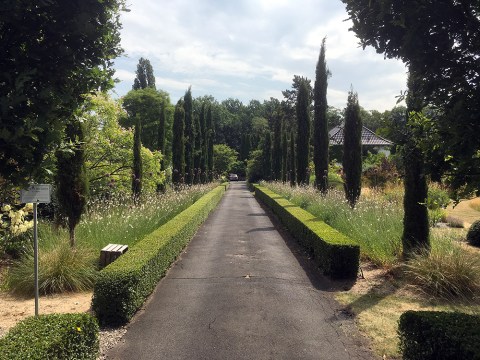Archive for the ‘public gardens’ Category
Saint Andre Gardens
Another French garden I liked was Abbaye Saint Andre Gardens in Avignon. Different from the Loire gardens, very south-of-France, very Provencal. Hot sun and dry gravel, hard shadowlines. It was scorching hot and cicadas were absolutely screaming while I was there.
The Chateau Villandry Gardens
Villandry is the one. After 4 trips and about 10,000 kilometers of cycling in Europe, if I were asked to recommend a single European garden, to choose one garden for the most representative old-world garden experience, I’d choose Chateau Villandry in the Loire Valley. It has everything you want: elaborate formal gardens, a smaller ‘English’ garden, a silly lawn garden, ponds, fountains, allees, parterres, and a pleasant woodland area to give you a break from all the hedgy-ness. It’s great. I have a slight caveat that Quinta de Regaleira in Portugal is more fun and quirky, and the other French garden I love — Vaux les Vicomte — has a more dramatic formal garden with some unique design trickery and is ultimately more historically significant, so I’d recommend that everyone go see those gardens too (I’ll make a post for Vaux les Vicomte at some point), but for a single garden visit with everything you want from an old world garden, I would pick Villandry.
These two photos basically capture why I find it such a good representation of old world gardening. The two plantings are both excessive and contrived, and moving between them makes the experience of each one more dramatic and enjoyable.
As befits my choice as the representative garden of France or Europe, a slew of photos are below. Cheers. (more…)
Blanc Green Wall
I did another bike trip in Europe this summer, this time riding from Paris to Bologna. I’ll probably do about a half dozen posts from that trip. This is the first one, a few photos of a green wall on the side of the Musee de Quai in Paris. It’s by Patrick Blanc, the green-haired frenchman who designed the Drew School green wall in San Francisco that I’ve posted about several times: 2011, 2013 and 2016. The Drew School wall was a lot of fun to see the first time, and remains a nice feature even though the plantings haven’t aged exceptionally well. This Paris green wall is in better shape. Most of it is lush and it’s an exuberant element in a city that needs as much vegetation as it can get.
The Tree Museum
Happy new year. I’m still posting things from my bike trip from Amsterdam to Bologna last summer. This is another garden, but quite different from the others. It’s branded as a Tree Museum, which is a great concept, but I’d describe it as a sculpture garden, with the trees as the sculpture. Maybe those are not mutually exclusive terms; it certainly has the rarefied air of a museum. The creator is a Swiss landscape architect/nurseryman who specializes in moving large trees. Over the years he built up a collection of trees and at some point he decided to create a garden to display them. I love the way the walls are used to frame the trees.
Hortus
My favorite garden in Europe after or alongside Vlinderhof is Hortus, the home garden and nursery of Peter Janke in Hilden, Germany, near Cologne. It’s great. It feaatures classic design elements but sometimes tweaked with more contemporary materials and a modern sense of balance. I find I can usually tell everything that’s happening in a formal garden with a single glance, but his garden is worth exploring. Nice plant combos and interesting contrasts between formal geometry and informal plantings. I took a lot of photos and could have easily taken more.
Hermannshof Garden
‘At Hermannshof we don’t follow trends. We make them.’ Cassian Schmidt, feeling his oats.
In Germany I visited Hermannshof, a botanical garden a little south of Frankfurt. The garden goes back hundreds of years, but in the last couple decades it has become known for experimental meadow plantings designed by its horticulturalist Cassian Schmidt. Apparently, he has trialed and introduced a lot of plants over the years, and influenced Dutch and German designers, including Piet Oudolf. It’s a lovely garden, but as a designer from California, I found it hard to figure out what was experimental or which plants were Hermannshof introductions; most of the plants were familiar to me and I didn’t see anything particularly novel or surprising about the way they were combined in the meadow plantings. It was all very nice, but seemed well in line with plantings in the botanical gardens we have in California. But afterwards I listened to a talk he gave for a Beth Chatto symposium, and it gave some background about the research and methods underlying the plantings. The talk is embedded at the end of the post; this link takes you to slides from the talk, including some interesting graphics and photos that blow doors off the photos I took at the garden.
In any case, it’s a lovely garden. The meadows are planted in large blocks and their effect is pretty dramatic as a result. A bunch of plants of similar heights will almost always look nice together, and this was no exception. Echinacia and grasses, Euphorbia and grasses, Gaura and grasses, it’s all pretty nice.
You are currently browsing the archives for the public gardens category.























